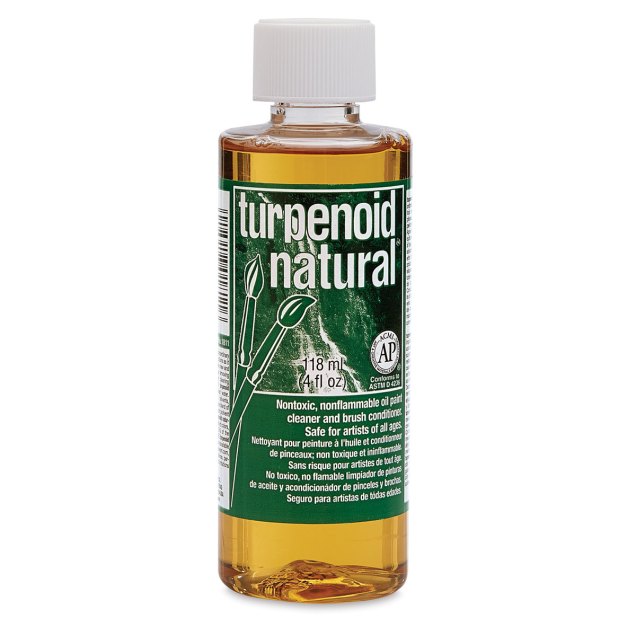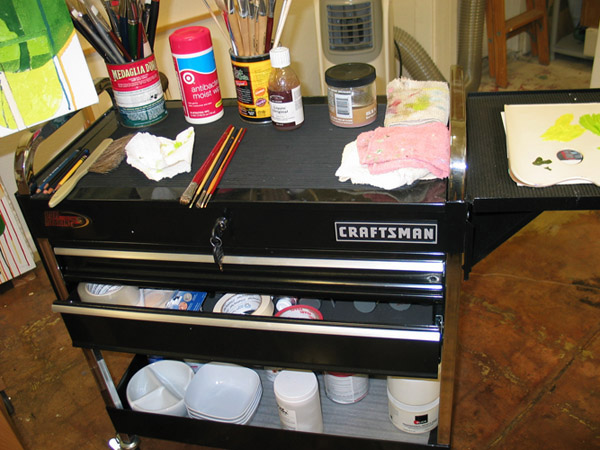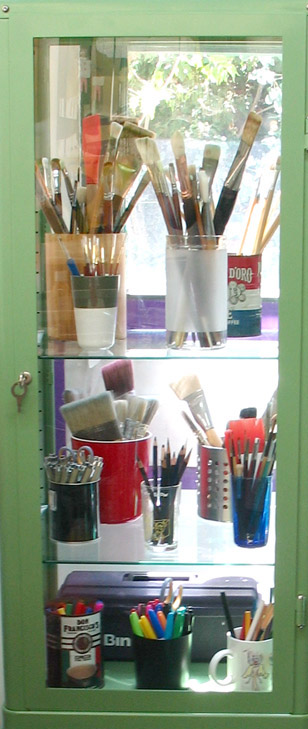Artyczar
Moderator
- Messages
- 13,708
I am posting this, I guess as a tutorial for anyone who might be interested in how to use oils. I am completely self-taught, so take it for what that's worth to you. This is my system and my viewpoint on oil painting. I am not a teacher by any stretch of the imagination. But I have been working in oils for over 30 years, so at least that's something.
This is all reworded from something I posted on my blog some time ago which was meant to help anyone who has felt intimidated by oil painting in general. A lot of people that want to start in this medium can get easily discouraged, like it’s some kind of ominous medium that they won’t be able to conquer. I, for one, don’t know how people work in acrylic because it dries so fast. Acrylics are not my bag at all.
Oils stay wet forever practically--some colors more than others. But I think the number one barrier as to why people don’t try, and/or fail, is because they don’t know how to care for the materials. I really believe that is the reason. Working with the actual paint is usually not the reason. All painting is trial and error. You get to know how to manipulate the stuff by pushing it out of the tube onto the palette, and brushing it on a canvas. It’s not all that different from acrylics in that regard.
It’s the cleaning up afterward and taking care of your brushes that stops a lot of people, and many are afraid of the smell. The "toxicity." It’s not all that horrible really. You can wear gloves and a mask if it really freaks you out that much. I personally don’t think all that’s needed. Use a fan and open a window is you’re that paranoid. I don't do any of that.
First of all, I use a nontoxic cleaner called Turpenoid Natural:

I keep it contained inside of a Silicoil jar:

You fill the jar until it just covers over the coil. You won't need to put much more into the jar for quite a long time. You can also keep that same Silicoil jar for over a year before correctly disposing of it. (Don’t pour it down the sink, ever.) Once you clean your brush off on the coil, the color will settle to the bottom of the jar. The clearer part of the solution will rise to the top over time. It's a great little system.
This is all part of taking care of your brushes, which is most important. And I have owned most of my brushes for more than 25+ years.
While I'm painting, I use disinfectant wipes between colors on the same brush before dipping it into the Silicoil jar and brushing it against the coil. Those disinfectant wipes are incredibly helpful, but paper towels or rags work well too. (I might make more trash than I should, but I use all three for what it's worth.) For a smaller brush, I find that a disinfecting wipe is good enough to use (between colors) and I don’t even have to dip the thing into the turp at all.
I also use disposable paper palette pads. I used to have a glass palette, but I found that I actually wasted paint that way. I'll use two pads at once, and I'm also able to easily transfer mixed colors to a new pad with a palette knife if needed. It's all much much faster. By the way, I don't use the ones with the thumb holes in them even though they are pictured here.

As far as mediums, I only really use two different kinds. I mostly use this Gamblin gel that makes oils a smooth dream to paint with. It's also non-toxic and you only need a tiny bit.

The other stuff I use is Liquin, which has a a bit of a toxic smell to it. I don't use it that often, but I will when I need to. It helps getting oils to dry much faster. It thins out the oil paint and makes it somewhat transparent. You can even make oils look almost like watercolors. It's the secret for building flat layers upon layers, especially if you’re playing with light.

After the painting session is over, you'd think there'd be a whole rigmarole to cleaning up. Nope. I basically do the same thing as when I'm trading colors on the same brush. Use a rag or a disinfectant wipe to get most of the color off the brush first, then wipe it on the coil in the jar until all the color disappears. I'll give it a couple gentle swipes on a rag and set it down. I'll let it sit there until I'm ready to paint again.

I can leave the brush there forever practically before soap-cleaning it, as long as it’s free of color. I have left my brushes sitting this way for a year before. So long as they have a slight coat of the Turpenoid on them, they will actually be fine.
Then, when I want to give the brushes a good washing, I actually use LAVA soap with warm water until all the color is gone from the brush. It must wash out clear. THEN, here's the stuff to give it the last washing and a good conditioning (this is important):

I'll dry the brushes off with a soft, clean cloth, making sure that wood handle never sits wet. Then, I will shape the brush bristles with my fingers and spit. Yes, I said spit. Don't ever put brushes into your mouth. I spit into the palm of my hand and do it that way. I always store my brushes with the bristles facing up.

I hope this was somewhat helpful.
This is all reworded from something I posted on my blog some time ago which was meant to help anyone who has felt intimidated by oil painting in general. A lot of people that want to start in this medium can get easily discouraged, like it’s some kind of ominous medium that they won’t be able to conquer. I, for one, don’t know how people work in acrylic because it dries so fast. Acrylics are not my bag at all.
Oils stay wet forever practically--some colors more than others. But I think the number one barrier as to why people don’t try, and/or fail, is because they don’t know how to care for the materials. I really believe that is the reason. Working with the actual paint is usually not the reason. All painting is trial and error. You get to know how to manipulate the stuff by pushing it out of the tube onto the palette, and brushing it on a canvas. It’s not all that different from acrylics in that regard.
It’s the cleaning up afterward and taking care of your brushes that stops a lot of people, and many are afraid of the smell. The "toxicity." It’s not all that horrible really. You can wear gloves and a mask if it really freaks you out that much. I personally don’t think all that’s needed. Use a fan and open a window is you’re that paranoid. I don't do any of that.
First of all, I use a nontoxic cleaner called Turpenoid Natural:

I keep it contained inside of a Silicoil jar:

You fill the jar until it just covers over the coil. You won't need to put much more into the jar for quite a long time. You can also keep that same Silicoil jar for over a year before correctly disposing of it. (Don’t pour it down the sink, ever.) Once you clean your brush off on the coil, the color will settle to the bottom of the jar. The clearer part of the solution will rise to the top over time. It's a great little system.
This is all part of taking care of your brushes, which is most important. And I have owned most of my brushes for more than 25+ years.
While I'm painting, I use disinfectant wipes between colors on the same brush before dipping it into the Silicoil jar and brushing it against the coil. Those disinfectant wipes are incredibly helpful, but paper towels or rags work well too. (I might make more trash than I should, but I use all three for what it's worth.) For a smaller brush, I find that a disinfecting wipe is good enough to use (between colors) and I don’t even have to dip the thing into the turp at all.
I also use disposable paper palette pads. I used to have a glass palette, but I found that I actually wasted paint that way. I'll use two pads at once, and I'm also able to easily transfer mixed colors to a new pad with a palette knife if needed. It's all much much faster. By the way, I don't use the ones with the thumb holes in them even though they are pictured here.

As far as mediums, I only really use two different kinds. I mostly use this Gamblin gel that makes oils a smooth dream to paint with. It's also non-toxic and you only need a tiny bit.

The other stuff I use is Liquin, which has a a bit of a toxic smell to it. I don't use it that often, but I will when I need to. It helps getting oils to dry much faster. It thins out the oil paint and makes it somewhat transparent. You can even make oils look almost like watercolors. It's the secret for building flat layers upon layers, especially if you’re playing with light.
After the painting session is over, you'd think there'd be a whole rigmarole to cleaning up. Nope. I basically do the same thing as when I'm trading colors on the same brush. Use a rag or a disinfectant wipe to get most of the color off the brush first, then wipe it on the coil in the jar until all the color disappears. I'll give it a couple gentle swipes on a rag and set it down. I'll let it sit there until I'm ready to paint again.

I can leave the brush there forever practically before soap-cleaning it, as long as it’s free of color. I have left my brushes sitting this way for a year before. So long as they have a slight coat of the Turpenoid on them, they will actually be fine.
Then, when I want to give the brushes a good washing, I actually use LAVA soap with warm water until all the color is gone from the brush. It must wash out clear. THEN, here's the stuff to give it the last washing and a good conditioning (this is important):

I'll dry the brushes off with a soft, clean cloth, making sure that wood handle never sits wet. Then, I will shape the brush bristles with my fingers and spit. Yes, I said spit. Don't ever put brushes into your mouth. I spit into the palm of my hand and do it that way. I always store my brushes with the bristles facing up.

I hope this was somewhat helpful.

 To wipe paint off brushes, I recycle books like voter info, some catalogues, telephone type, "newsprint" type books. When a page is used up. I tear it off and put it into a plastic bag in a bucket, cover with water, and add to it till garbage day, when it goes into the trash.
To wipe paint off brushes, I recycle books like voter info, some catalogues, telephone type, "newsprint" type books. When a page is used up. I tear it off and put it into a plastic bag in a bucket, cover with water, and add to it till garbage day, when it goes into the trash. I tried oils for the first time a while back, just before Covid hit, and had a second go this year, attending workshops for beginners in oils. I’ve not heard of the coil jars, so have learned something new. I have been thinking of getting water-based oils.
I tried oils for the first time a while back, just before Covid hit, and had a second go this year, attending workshops for beginners in oils. I’ve not heard of the coil jars, so have learned something new. I have been thinking of getting water-based oils.

 )
)